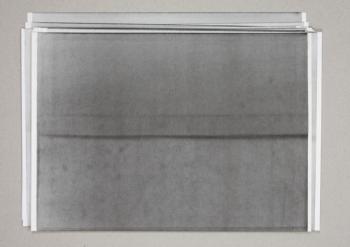Curator: Veronika Resslová
The painter Jaromír Novotný works in the space between industrial printing and painting. His canvases demonstrate a subtle sensuality and a concentration on detail, somehow unique in the context of contemporary painting. The author consistently ignores any representational possibilities or potential denotative qualities of the medium of painting, while also reducing to a minimum the choices of painterly means: the processes of printing and painting are reduced to their basic technical foundations – a plastic foam paint roller and the standard industrial hues of offset ink (CMYK) .
In strictly defining his preconditions for producing these images, the artist approaches the boundaries of industrial production, and suppresses his authorial personality, bringing the very process of painting into focus. In a certain sense, the author's work can be read as temporal recording of a single gesture repeated many times under the prescribed conditions, carefully prepared in advance, simultaneously having the qualities of a laboratory experiment or a meditation. The painter repeatedly uses the "same" component in the "same" situation and carefully observes the painting process. Such an interpretation may find a deeper meaning in the work considered as a whole, rather than as individual works, but it is a whole that can never be completed, because the continuum of awareness that is visualized here does not develop in a linear way.
The minimum amount of undiluted industrially manufactured offset printing ink (in most cases the author uses black) is spread over the canvas repeatedly until the color dries. The resulting surface allows the viewer’s eye to move in a kind of shallow relief, which bears the traces of unanticipated occurrences, or of the structure of the substrate. Therefore, the resulting image cannot be seen simply as a geometric sign: it rewards a protracted lingering over the materiality of the painting, as well as a reading of the accumulated movements of the artist’s tools. At the same time, we cannot read it as a lyrical abstraction: the author defies also this interpretation, refusing anything but a strictly factual interpretation, and consistently reducing painting to its fundamental technological conditions.
Although the images are often divided into several horizontal strips, the actual painting is exclusively vertical, and adopting the dimensions of a standing man. Its proportions are usually one to one, but the author also makes use of other possible options there. As for the random elements present in the image (trash, the structure of the substrate, the echoes of adhesive tape), it seems as if its selection has been done in a rather negative way, as if the author were more aware of what the image should not be (and then assiduously removed or sidestepped these issues) rather than predicting the final resulting image.
Novotný attends also to the details in the method of installation: sometimes the canvases have not been stretched, and he allows them to hang limply, lending even more uncertainty to the division between painting and printing; or by spreading a magenta layer over the window glass of a cemetery hall (Galerie Nashledanou); or in taking the form of processional banners (Kostel Nejsvětějšího Salvátora).
In addition Novotný’s abstract photos occupy a remarkable place in his work. The artist’s use of the photographic process is analogous to his painting practice – in daylight, he repeatedly applies developer to sections of photographic paper, and then fixes it. Again, instead of any kind of representation only the process of developing takes place here, revealing the painterly potential of exposure test strips. In addition to the richly differentiated scale of lights and darks, delicate shades of purple, brown and pink also appear on the overexposed paper.
For the non-gallery space White Billboard Jaromír Novotný has compiled a sequence of smaller works made on office paper. A simple arrangement of individual prints gives an undulating horizontal line (which is visually similar to the vibrating string of a musical instrument). The title of the installation comes from a musical sign — the symbol fermata suggests the possibility of a prolongation of the appropriate tone.
“I’m covering A4 office paper with black ink. In striking of the top edge of the paper repeatedly, fuzzy horizontal line is transferred to the paper. I do this mechanically, but the result is always a vague lyrical abstraction which arises on it’s own, and the final effect is somehow antithetical to the method. What to do with the papers next? You can sort them by various parameters. This time I’ll try to adjust the stripe into a longer horizontal line, which is the visual equivalent of a long tone, or a string in different degrees of amplitude. The white vertical edges (traces of adhesive tape) can serve to mark musical measures.” (JN)


